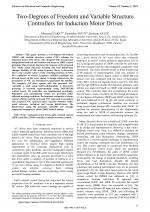| 1/2018 - 9 |
Two-Degrees of Freedom and Variable Structure Controllers for Induction Motor DrivesZAKY, M. |
| Extra paper information in |
| Click to see author's profile in |
| Download PDF |
Author keywords
induction motor drives, field oriented control, 1DOF controller, 2DOF controller, variable structure control
References keywords
control(30), motor(11), speed(9), mode(9), electronics(9), sliding(8), industrial(8), robust(7), freedom(7), drives(7)
Blue keywords are present in both the references section and the paper title.
About this article
Date of Publication: 2018-02-28
Volume 18, Issue 1, Year 2018, On page(s): 71 - 80
ISSN: 1582-7445, e-ISSN: 1844-7600
Digital Object Identifier: 10.4316/AECE.2018.01009
Web of Science Accession Number: 000426449500009
SCOPUS ID: 85043257643
Abstract
This paper presents a two-degrees-of-Freedom (2DOF) and variable structure control (VSC) schemes for induction motor (IM) drives. The designed VSC incorporates independent feedback and feedforward terms as 2DOF control principle. This structure improves the response of the proposed VSC under speed reference tracking and load disturbance changes. Stability of VSC using Lyapunov theory is discussed. Due to the variable nature of the switching function of VSC, two conditions to ensure Lyapunov stability candidate are derived based on the error signal. A design criterion for the parameters of VSC are introduced to guarantee the stability. The complete IM drive system with the proposed VSC controller is built using MATLAB/Simulink. A laboratory prototype is executed experimentally using DSP-DS1104 control board. All controllers are implemented practically. Simulation and experimental results are provided under different working conditions. Performance evaluation of classic control schemes and the proposed VSC approach is presented. The proposed VSC approach gives superior behavior under speed reference variations and torque disturbances. The disturbances using the proposed controller are strongly suppressed compared to classic 2DOF control scheme. |
| References | | | Cited By |
Web of Science® Times Cited: 2 [View]
View record in Web of Science® [View]
View Related Records® [View]
Updated today
SCOPUS® Times Cited: 8
View record in SCOPUS® [Free preview]
View citations in SCOPUS® [Free preview]
[1] Three-phase SEPIC PFC for three-phase IM drive under unbalanced and distorted voltage supply, Al-Gahtani, Saad F., Azazi, Haitham Z., Elbarbary, Z. M. Salem, Electrical Engineering, ISSN 0948-7921, Issue 1, Volume 103, 2021.
Digital Object Identifier: 10.1007/s00202-020-01085-5 [CrossRef]
[2] Comparative Analysis Between the PI Speed Controller and Two-Degrees-of-Freedom Speed Controller for Induction Motor Drive, Gogea, Alexandru, Stoicuta, Olimpiu, Pana, Teodor, 2019 8th International Conference on Modern Power Systems (MPS), ISBN 978-1-7281-0750-9, 2019.
Digital Object Identifier: 10.1109/MPS.2019.8759711 [CrossRef]
Disclaimer: All information displayed above was retrieved by using remote connections to respective databases. For the best user experience, we update all data by using background processes, and use caches in order to reduce the load on the servers we retrieve the information from. As we have no control on the availability of the database servers and sometimes the Internet connectivity may be affected, we do not guarantee the information is correct or complete. For the most accurate data, please always consult the database sites directly. Some external links require authentication or an institutional subscription.
Web of Science® is a registered trademark of Clarivate Analytics, Scopus® is a registered trademark of Elsevier B.V., other product names, company names, brand names, trademarks and logos are the property of their respective owners.
Faculty of Electrical Engineering and Computer Science
Stefan cel Mare University of Suceava, Romania
All rights reserved: Advances in Electrical and Computer Engineering is a registered trademark of the Stefan cel Mare University of Suceava. No part of this publication may be reproduced, stored in a retrieval system, photocopied, recorded or archived, without the written permission from the Editor. When authors submit their papers for publication, they agree that the copyright for their article be transferred to the Faculty of Electrical Engineering and Computer Science, Stefan cel Mare University of Suceava, Romania, if and only if the articles are accepted for publication. The copyright covers the exclusive rights to reproduce and distribute the article, including reprints and translations.
Permission for other use: The copyright owner's consent does not extend to copying for general distribution, for promotion, for creating new works, or for resale. Specific written permission must be obtained from the Editor for such copying. Direct linking to files hosted on this website is strictly prohibited.
Disclaimer: Whilst every effort is made by the publishers and editorial board to see that no inaccurate or misleading data, opinions or statements appear in this journal, they wish to make it clear that all information and opinions formulated in the articles, as well as linguistic accuracy, are the sole responsibility of the author.



